The Indian jewelry brand recently opened stores in Atlanta and Seattle.
In Results of Diversity Survey, a Tale of Two Experiences
National Jeweler breaks down the results of the survey on diversity in the fine jewelry industry that it conducted in partnership with Jewelers of America.

Conducted by Jewelers of America and National Jeweler in fall 2020, the “Diversity in the Fine Jewelry Industry” survey was limited to U.S.-based companies and broken down into three segments: one directed at employers, one for self-employed individuals, and one for employees.
This story focuses on the results of the survey directed toward employers (defined as owners or C-suite executives) in the fine jewelry industry. An analysis of the survey geared toward employees will be published on NationalJeweler.com as well.
A total of 473 individuals took the employer-focused diversity survey, with the survey completed by more men (61 percent) than women (35 percent). (The remaining 4 percent selected “other” when asked about their gender.)
The majority of respondents identified themselves as owners of retail stores (65 percent), while 10 percent were manufacturers, 8 percent were jewelry designers and 6 percent were wholesalers.
Most of these companies (88 percent) employ between two and 25 people.
When asked to rate their company’s performance in various areas as they relate to racial justice and equity, the survey-takers gave themselves high marks across the board, with 71 percent rating themselves as “very good”—the survey’s top rating—overall.
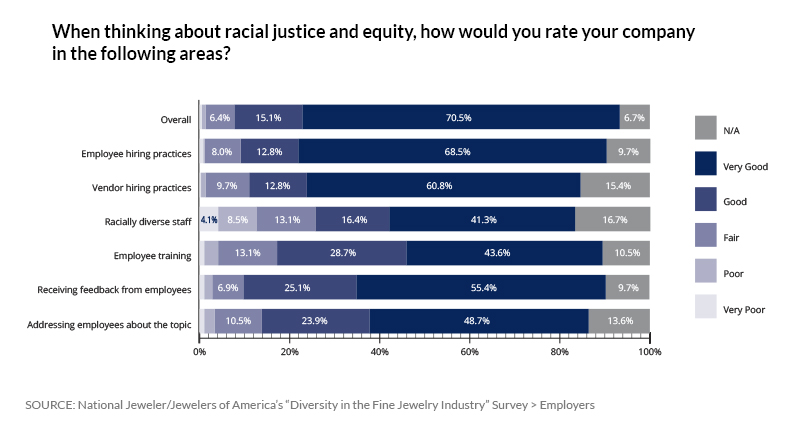
Looking at specific categories, the majority of respondents said they are “very good” when it comes to diversity in employee hiring (69 percent) and vendor hiring (61 percent), and as it relates to processing feedback on racial justice-related issues from employees (55 percent).
They gave themselves somewhat lower marks for addressing employees about racial justice (49 percent said they were “very good” at this) and employee training in this area (44 percent).
And, about half of survey-takers said the current push for racial justice and equity wasn’t going to change how their company approached the hiring of employees (47 percent) or vendors (47 percent) or their company’s racial discrimination policy (46 percent), which is non-existent at about half the companies that took the survey.
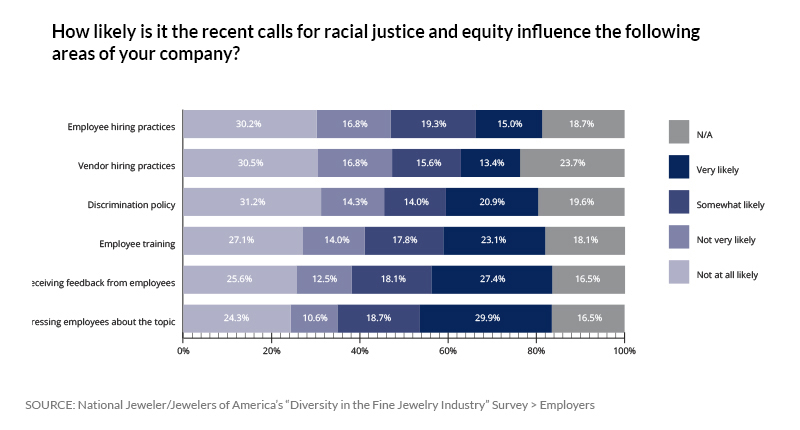
Most respondents who rated their company as having a “very good” performance overall in areas of racial justice and equity chose to elaborate on their response.
A few wrote their company has been focused on diversity and inclusion for years, some because they have experienced discrimination firsthand.
One survey-taker said: “Being a black-owned business and being
Others who rated their company as “very good” did so pre-emptively it seems; it’s not an issue their company has tackled yet, but they expect it will.
“Over the years, I think we have done an exceptional job at addressing gender diversity issues and hiring,” one respondent wrote.
“However, most recently we have turned our attention to areas of opportunities with respect to hiring within the BIPOC community. Recent social and racial tensions in the U.S have prompted us to take a moment of self-reflection. In so doing, it became apparent that this seem to be the one demographic where we have underachieved, at least with respect to our aspirations to be an inclusive, diverse environment.”
Others said they rated their company as “very good” because, in their view, they treat everyone equally.
A few described themselves as being “color blind” or noted they “don’t see color.”
One respondent, who identified as white, wrote: “I was raised on an Air Force base … the military does not see color; they are all our brothers. I run my business the way I was raised, to hire and promote on an individual’s ability and merit. If they deliver and continue to have a positive attitude to help the company grow and prosper, they will be rewarded accordingly.”
Expressions such as these are often used to impart the idea that an individual is not personally biased or discriminatory, but, as many experts have discussed, they can actually be harmful to diversity and inclusion efforts.
A Closer Look
At first glance, the survey paints a picture of an industry that is diverse, open, and inclusive. Take into account the race of the respondents, however, and that picture starts to shift.
The vast majority of jewelry industry employers who responded to the survey—77 percent—were white.
Fewer than 100 survey-takers identified as a person of color, accounting for 13 percent of the total respondents. Four percent were Asian; 3 percent Black; 3 percent Hispanic or Latino; 2 percent multiracial or biracial; and 1 percent American Indian or Alaska Native.
Among that 13 percent, the majority were owners or executives at retail stores (48 percent) or in the field of jewelry design (22 percent), with most (76 percent) identifying as the owner of their business rather than a C-suite executive (24 percent).
Respondents of color gave their companies lower marks when it comes to racial justice and equity.
The percentage who rated their company as “very good” overall was 63, down from 71 percent when all responses are taken into account.
Nearly a quarter rated their company as “fair” or “poor” when it comes to diversity in vendor hiring—as opposed to 11 percent of all survey-takers—while 19 percent rated their company as such when it comes to addressing employees on the topic, compared with 13 percent of all survey participants.
Another 19 percent gave “fair” or “poor” marks for employee training, up from the 16 percent who said the same thing when looking at all results.
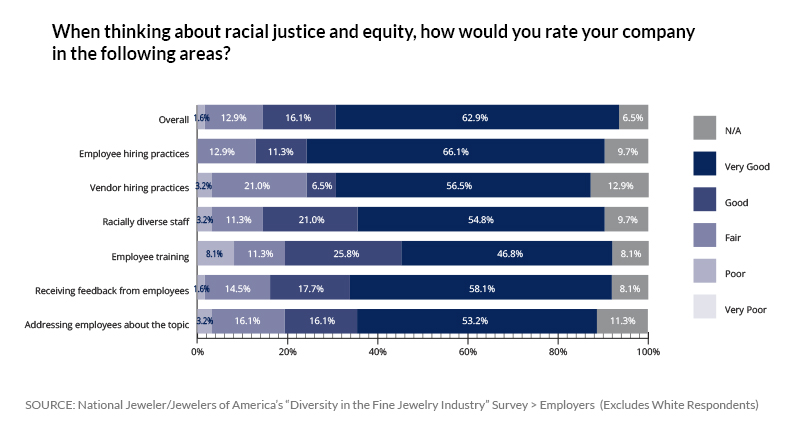
“I believe that my company viewed [racial justice] as a political issue, rather than a human rights issue,” one respondent, who identified as Black, wrote. “2020 has caused a shift in perspective, and they are now actively working toward improving our work culture. In my past experience, this was never addressed or perhaps seen as an HR concern, rather than something that needed to be addressed companywide.”
The respondent continued: “When our company did make a public statement, we received a lot of backlash from people and it really set the tone for how the jewelry industry is not quite open to these conversations, but they must be had.”
RELATED CONTENT: Diversity, Equity and Inclusion—Why They Matter
National Jeweler and Jewelers of America’s “Diversity in the Fine Jewelry Industry” survey was conducted from Sept. 23 to Oct. 14, and all responses were anonymous.
The organizations created and launched the survey in the wake of the 2020 nationwide protests for racial justice. The survey goal was to better understand the experiences of people of color—particularly Black professionals—in the fine jewelry industry.
The protests kicked off discussions about racial inequities, discrimination, and injustice in all industries, and the jewelry industry was not immune.
Conversations cropped up on social media platforms, companies and associations industrywide organized panels on diversity, and jewelry businesses brought in diversity trainers.
Also in 2020, a group of Black gem, jewelry and watch industry professionals launched the Black in Jewelry Coalition.
BIJC is the first nonprofit association dedicated to the inclusion and advancement of Black professionals in the industry, and its launch comes at a time many see as a major turning point for racial justice and equity in America.
The Work Ahead
While the majority of employers ranked themselves as “very good” overall when it comes to racial justice and equity, their answers to other questions indicate there is more work to be done.
As previously mentioned, jewelry company owners and C-suite executives gave their companies high marks for diversity in employee hiring, with 82 percent ranking themselves as “good” (13 percent) or “very good” (69 percent).
No other area of company operation garnered such high marks from employers when it comes to racial justice and equity.
Yet, the area to receive the lowest percentage of “very good” rankings is one that involves putting the idea of diversity into action.
Only 41 percent of employers rated themselves as “very good” when it comes to actually having a racially diverse staff, while one-quarter of respondents rated themselves as “fair” (13 percent), “poor” (9 percent), or “very poor” (4 percent) in this area.
“We have just started to come out as a company with a statement about racial justice and equality,” one respondent wrote. “We now need to follow through. We also need to hire more diverse staff and make sure our designers reflect the equity we want to put forward.”
A number of survey-takers said their ability to have a more diverse staff was limited by available candidates—a few noted they’ve never had a person of color apply for a job at their company—or because their business is a one- or two-person operation.
“I have one employee,” one respondent wrote. “Our geographic area is predominantly white. I did not have any non-white applicants during the hiring process. I grew up in a diverse environment and would like to bring diversity into my business. It has been on my mind from the beginning.”
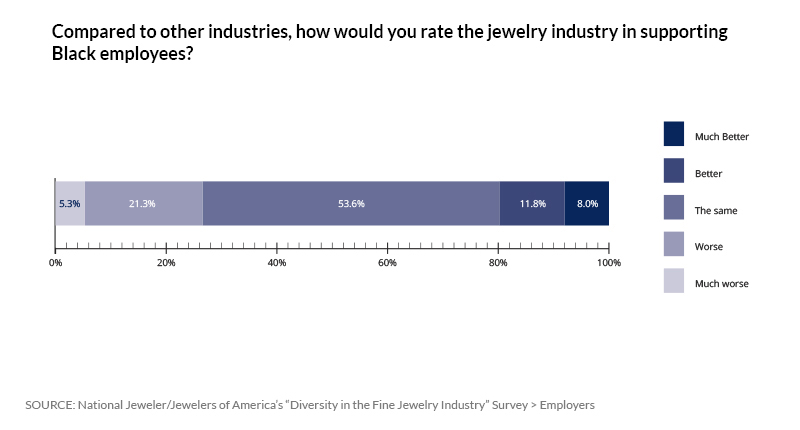
The survey also asked respondents to compare the jewelry industry’s treatment of its Black employees to other industries, and it inquired about their willingness to make it better.
One-quarter of survey-takers said they believed the jewelry industry is worse (21 percent) or much worse (5 percent) than other industries when it comes to supporting Black employees.
Meanwhile, 46 percent said the industry does a “fair,” “poor,” or “very poor” job of supporting Black jewelry designers. Forty percent said the same about supporting Black-owned jewelry companies, and 35 percent about Black jewelry consumers.
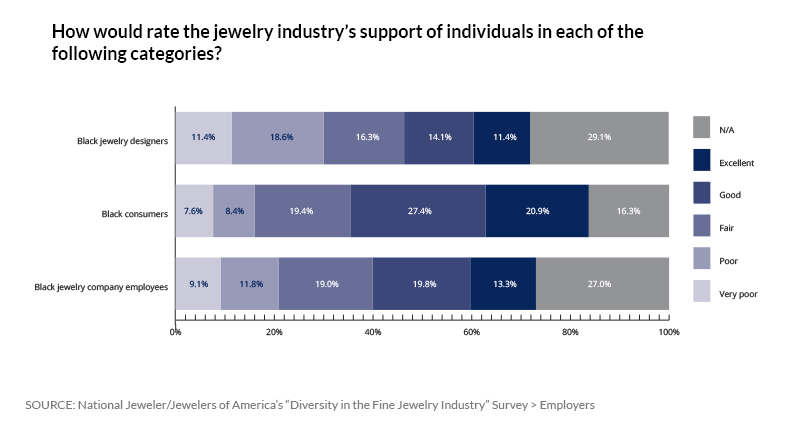
But, 74 percent of respondents expressed some level of interest in making changes to help the Black community: 18 percent are “slightly interested,” 34 percent are “interested,” and 22 percent are “very interested.”
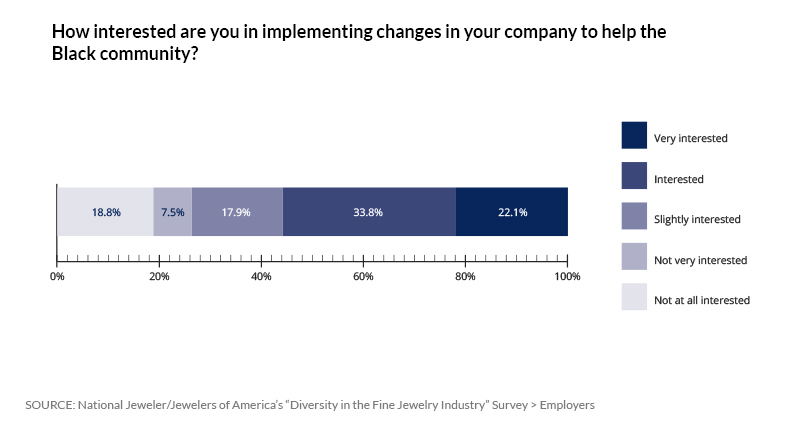
Write-in suggestions for resources included “give GIA training for affordable prices,” and “mentoring programs, apprenticeships, networking groups, etc.”
One respondent wrote: “We are a small shop in a rural area. Diversity is hard to come by but setting up a school with transportation to and from is a start.”
For full survey results, please visit Jewelers.org.
The Latest
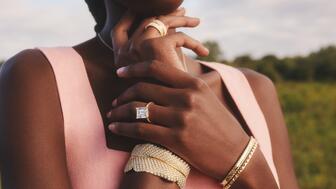
CEO Beth Gerstein shared its most popular price points, what’s trending in non-bridal fine jewelry, and its holiday performance.
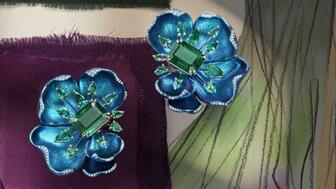
The 15 pieces were crafted from the “Insofu” emerald, discovered in Zambia in 2010.

Supplier Spotlight Sponsored by GIA
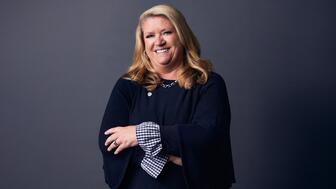
Chris Anderson is joining the insurance provider as the new chief financial officer and treasurer.

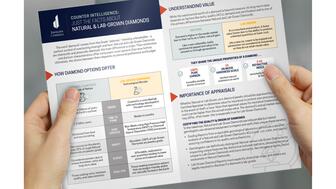
Jewelers of America is distributing a brochure for retailers to use when discussing the differences between natural and lab-grown diamonds.
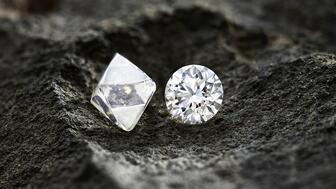
The industry is changing as it grapples with new realities around distribution, supply, and the need for consistent, effective marketing.
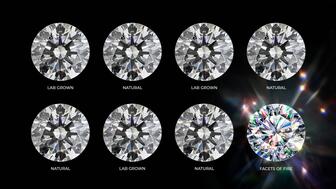
Natural diamonds mean more than lab-grown, but when every cut is ideal, they all look the same. Customers want more—Facets of Fire delivers.

Bhansali discusses the potential impact of U.S. tariffs, demand for diamonds by market, and the “cautious confidence” in India right now.

As lab-grown diamond brands pop up across India, academics are researching how to grow demand outside of the jewelry industry.

Govind Dholakia and Tanishq will be recognized for their contributions to the industry at the Diamonds Do Good Awards in Las Vegas.

The New York City-based brand has opened its first U.K. location with a permanent shop-in-shop at Liberty in London.
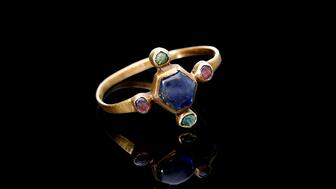
A metal detectorist discovered the ring that is believed to have belonged to a bishop in the late 12th to early 13th century.

Organizers looked to new partnerships and interactive experiences to enhance the spring show, set for March 16 to 18.
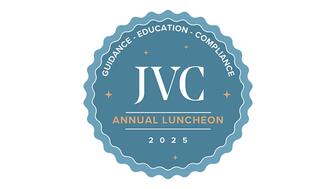
Kenewendo, Botswana’s minister of minerals and energy, will discuss the future of diamonds.

The suspect allegedly stole almost $800,000 worth of diamond jewelry from a store in Orlando and then swallowed it during a traffic stop.

Ahead of the Gem Awards on Friday, Jen Cullen Williams and Duvall O’Steen share pro tips for taking the best photos.

Founded in 2000, Marco Bicego is commemorating its milestone anniversary with a “25 Best” collection and campaigns honoring its heritage.

Those attending the company’s upcoming Zoom workshop will receive early access to “The List,” its new resource for finding buyers.

The organization will present an award to Amy-Elise Signeavsky, law enforcement and diamond recovery manager at GIA.

Chandler started his jewelry career at Michelson Jewelers, joining the Diamond Council of America as president and CEO in 2001.

Scottish American designer Maeve Gillies collaborated with Platinum Guild International on jewelry created by direct metal 3D printing.

Ahead of its trade show in May, TJS awarded free registration and accommodations to five up-and-coming jewelry industry professionals.

The 2025 Gem Awards are set to take place Friday at Cipriani 42nd Street in New York City.

The annual star-studded campaign for International Women’s Day encourages collective action against domestic violence.

The statement piece is seen in Yeprem’s new “You Play the Game” campaign, created for International Women’s Day.

Longtime employee Kyle Slosson has been promoted to the role.



























